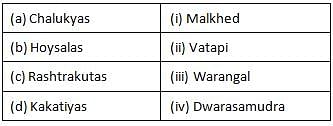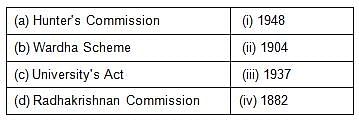SSC CGL Previous Year Questions: History - 7 - SSC CGL MCQ
30 Questions MCQ Test - SSC CGL Previous Year Questions: History - 7
Which one of the following inscriptions relate to the Chalukya king, Pulakesin II ? (SSC CHSL 2013)
Who among the following introduced the Mansabdari system ? (SSC CHSL 2013)
| 1 Crore+ students have signed up on EduRev. Have you? Download the App |
Which one of the following cities and the personalities associated with their establishment is wrongly matched ? (SSC CHSL 2013)
Which one of the following wars decided the fate of the French in India ? (SSC CHSL 2013)
The Crimean War came to an end by the (SSC CHSL 2013)
Name the Commander of the Arab army who conquered the Sindh. (SSC Multitasking 2013)
Who was the chairperson of the Chinese Communist Party at the time of liberation of China? (SSC Multitasking 2013)
Who was regarded by Gandhiji as his political Guru? (SSC Multitasking 2013)
Which among the following movements was not led by Mahatma Gandhi? (SSC Multitasking 2013)
In which session of the Indian National Congress was the “Poorna Swaraj” resolution adopted? (SSC Multitasking 2013)
The school of arts developed during the Kushan Period with the mixture of Indian and Greek style is known as (SSC Multitasking 2013)
Where was Christopher Columbus from? (SSC Multitasking 2013)
Which Sultan received a robe of honour from the caliph? (SSC Sub. Ins. 2013)
When Margaret Thatcher was P.M. with which country Britain waged a war to regain Control of Falkland Islands? (SSC Sub. Ins. 2013)
Match the following (SSC Sub. Ins. 2013)

The world's tallest statue of Mahatma Gandhi is in (SSC Sub. Ins. 2013)
Which one of the following is the principal source of information on Asoka's campaign against Kalinga ? (SSC Sub. Ins. 2013)
Gandhi's concept of Trusteeship: (SSC Sub. Ins. 2013)
The Gandhara art nourished under: (SSC Sub. Ins. 2013)
which one of the following land reform measures can be said to have been fully implemented by now in India? (SSC Stenographer 2013)
Which of the following recommended reservation for the Other Backward Classes (OBCs)? (SSC Stenographer 2013)
Which of the following was not an aspect of Later Vedic Age? (SSC Stenographer 2013)
Who among the follwing presided over the fourth Buddhist Council? (SSC Stenographer 2013)
Which of the following was not built by Firoz Shah Tughlaq? (SSC Stenographer 2013)
Who among the follwing granted permission to the English to establish their factory in India? (SSC Stenographer 2013)
The permanent Land Settlement in Bengal was introduced by (SSC Stenographer 2013)
Which king is referred to as Devanampiya Piyadassi (Belovedof the Gods) in the inscriptions? (SSC CGL 1st Sit. 2012)
Name the Maratha Saint who was a contemporary of Shivaji. (SSC CGL 1st Sit. 2012)
Which of the following cereals was among the first to be used by man? (SSC CGL 1st Sit. 2012)


















